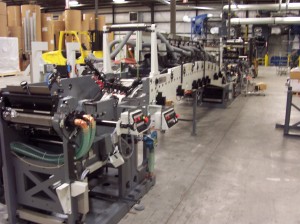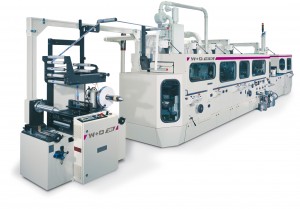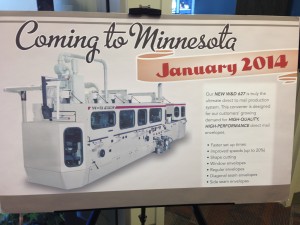Why International Paper Says It’s OK to Print Your Emails
By Andrea Newell | October 17th, 2013
“How many of you have a line at the end of your email (or gotten an email) that says, ‘Before printing this email, please consider the effects on the environment’? From a resource perspective and a wise use of natural resources, that’s a wise idea, but what I would like to do is challenge that.”
That’s how International Paper’s James McDonald started his SXSWEco discussion refuting the idea that most of us have that printing or using paper in the office causes deforestation and harms the environment.
Well, you might be thinking, he works for a paper company, what else is he going to say? McDonald acknowledged that it sounds self-serving, but still – he was determined to lay out his argument. “The truth is,” he said, “there are facts out there we’d like to go ahead and talk about.”
Setting aside the email paper use issue initially, McDonald weighed in on paper versus plastic, or renewable versus non-renewable resources.
There are many products, besides paper, that are made from forests, including furniture, lumber, cereals, deodorant, grout, cancer drugs, cinnamon, cork, toothpaste, antacids, and rayon. Many of them, McDonald explained, are made from sustainably, responsibly maintained forests. While managing this list may be even more daunting than dealing with paper responsibility, McDonald argues that trees are one of our most renewable resources, easily replanted and grown, as long as they are harvested responsibly so they can be replanted and regrown again. This cycle allows these products to continue to be made.
However, the largest use of wood in the world is still for fuel, at 53 percent, and, McDonald said, these forests are not usually replanted. Wood products follow at 28 percent, pulp, paper and packaging weigh in at 11 percent and miscellaneous use at 8 percent.
To continue to make wood products and paper, “we need a continued supply of trees to make those products, a sustainable, responsibly managed material, but…it’s not that simple from a global perspective.”
Some of the key drivers of deforestation include agriculture, land for livestock, mining and urban sprawl. Less than one percent of growing wood is harvested every year, despite population growth of over 200 percent, and forests in the United States have remained relatively flat in recent years. But, “we recognize that there are regions in the world where it is not happening as sustainably or responsibly as we would like it to be.”
Sixty-eight percent of the forests in the United States are working forests that generate income. McDonald estimates that 90 percent of those are privately owned and comprised of parcels of 100 acres or less.
Why is it important for companies like International Paper to have a reliable, sustainable source of material to make paper? McDonald believes that those landowners can have a more productive acre that yields more and takes pressure off harvesting from the world’s natural forests. “Not only is it the right thing to do,” McDonald says, “but I believe it is the only thing to do.”
How do we turn that principle into practice?
• Sourcing
• Certification
• Recycling
• Efficiency
International Paper guarantees its consumers that it will not source from illegal logging, from endangered forests, and certainly not from forests that threaten high-conservation values. How do they prove such a sourcing commitment? Through third party certification, which varies around the world, but IP works within the framework of each sourcing region in 24 countries, and that means understanding and following Sustainable Forestry Initiative guidelines, Programme for the Endorsement of Forest Certification (PEFC), Forest Stewardship Council and many more.
When it comes to recycling, McDonald says, paper is arguably one of the most-recovered or recycled products that humans use, weighing in at 46 mm tons in the U.S., versus 3 mm tons of glass, 2.7 mm tons plastic and less than 1 mm ton aluminum cans. Sixty-five percent of paper is recycled in the U.S., 72 percent in Europe and 46 percent in Brazil. Wood fiber can also be used 5-7 more times in other products. IP itself has a recycling service, part of the “wise use of raw materials.”
IP does keep an eye on its own carbon footprint, which can be significant, but it is focused on reducing its environmental impact around the world and reducing its water use, increasing its water efficiency, lowering its carbon emissions, continuing its certifications, and increasing its energy efficiency, along with currently using about 70 percent renewable energy. But, McDonald says, one of the most important goals they have is ensuring employee safety.
Philanthropically, IP works with NGOs such as The Nature Conservancy, the National Fish and Wildlife Foundation and the Dogwood Alliance to work toward safeguarding the environment.
We want to ensure that our global forests are healthy, that they’re able to provide the resources that we need, the recreation, the entertainment, and, certainly, the products for generations to come. But if I can leave you with one thought, as your finger hovers over the Print button, the next time you are considering printing that email, remember the renewability of the raw material, remember the renewability of energy that goes into the production of the product and the recycling ability of that product, that has the ability to go on to become several other products in its lifetime.”
So, is International Paper encouraging people to print emails? I asked Mr. McDonald that same question after the session.
“I used the printing example partially to get everyone’s attention, but also to illustrate that this is a complex issue. While there’s obviously merit in using all resources intelligently and avoiding unnecessary waste, taking care of forests is not as simple as ‘don’t print and save the environment,’” McDonald said.
While companies certainly shouldn’t halt any anti-printing campaigns and conserving paper is always a good thing, McDonald illustrated that sometimes we forget that there are other, very real threats to forests that we should also address, and if done well, responsibly managed forests will continue to source many everyday products we use long into the future.
“Unless people have a general understanding about sustainable forestry, demand for products and some of the true threats to global forests, the negative perceptions continue. Many people don’t realize that demand for forest products can help maintain responsibly managed working forests, and I thought the printing example was a good way to highlight this.”












